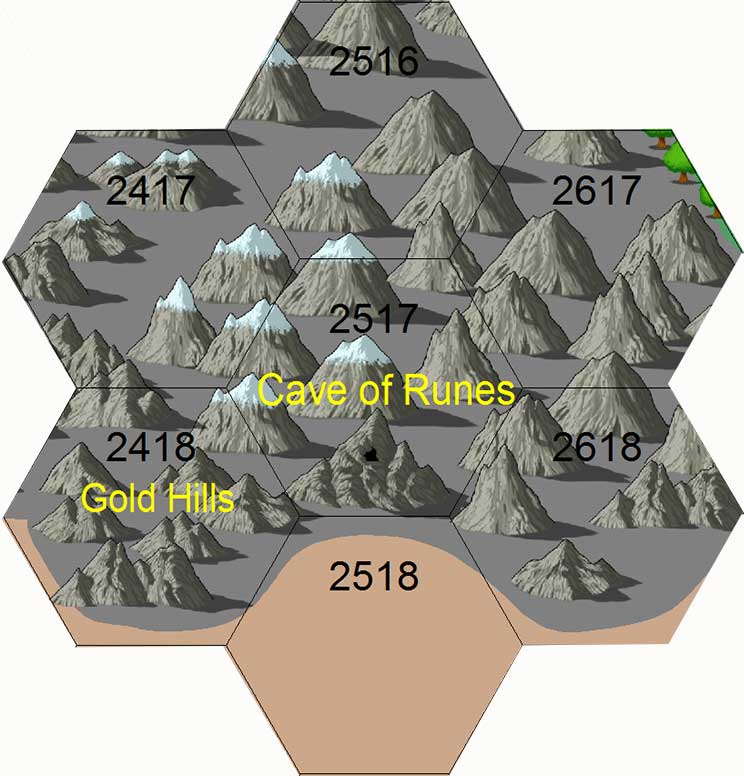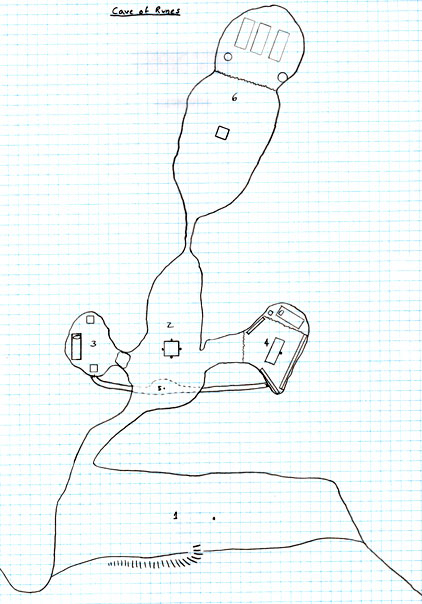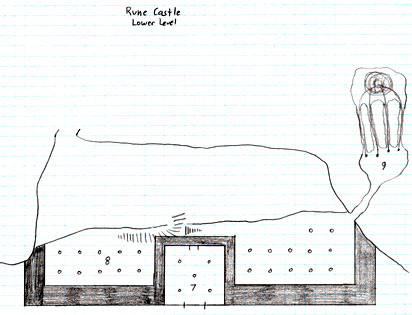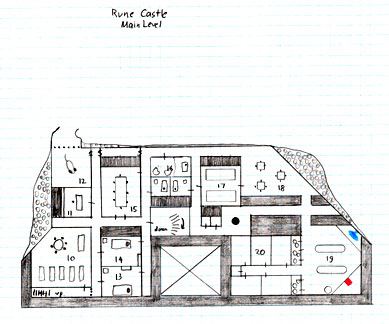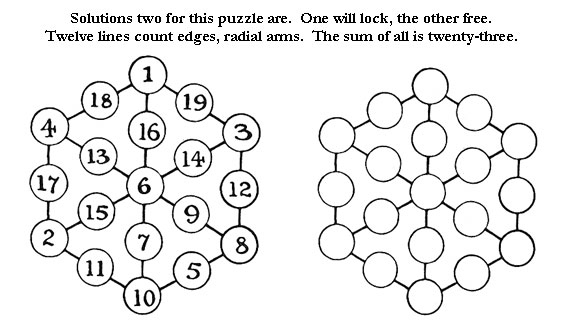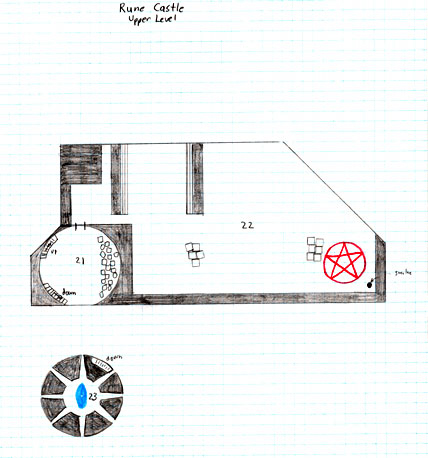Difference between revisions of "Runes, Runes Everywhere"
(Pushed from realm.) |
(Pushed from realm.) |
||
| Line 34: | Line 34: | ||
== Runic Musings == | == Runic Musings == | ||
| − | The drawer contains: several bottles of black ink, a steel-tipped stylus, and a plain leather-bound book about one inch thick. The front of the book is entitled Runic Musings. | + | The drawer contains: several bottles of black ink, a steel-tipped stylus, and a plain leather-bound book about one inch thick. The front of the book is entitled Runic Musings. The first entry in the book is dated March 15, 833. |
| − | |||
| − | The first entry in the book is dated March 15, 833. | ||
{| class="wikitable" style="background-color:#ebd5b3;" | {| class="wikitable" style="background-color:#ebd5b3;" | ||
Revision as of 22:19, 19 September 2016
| Type | Dungeon |
|---|---|
| Status | Explored September 888 TA |
| Location | Cave of Runes |
| Hex | 2517 |
| Campaign | The Elven Watch Campaign |
| Adventure # | 99 |
DM's Notes
The characters want to carve rune weapons to gain more power. The weapons can only be carved at the Cave of Runes. The runic language is a cool way to let them create items that are balanced and yet fun to play. It also gives the monsters a new way to torture them.
There are several factions trying to gain control of the Cave of Runes.
- Ernest Goodfellow and the Knights of Dragonsford. They have the book, although it is currently in the hands of Morgan the Enchanter who is a triple spy to Hylax and the Collegium Magicium.
- The Collegium Magicium. One branch of this august body believes that they can create a race of super wizards by having women birth their babies in the tendrils. The fact that they know about the tendrils is a tie back to Morgan.
This adventure has several different threads.
- The party learns that the Cave has been claimed by some unknown force.
- Hylax is warned to keep the party from trying to take over the Cave.
- Let the characters exchange rune items for new rune cards. Also, characters who can prove rune knowledge from previous materials can get rune cards.
Runic Musings
The drawer contains: several bottles of black ink, a steel-tipped stylus, and a plain leather-bound book about one inch thick. The front of the book is entitled Runic Musings. The first entry in the book is dated March 15, 833.
| It seems as if the inevitable has happened. The generators aboard the great ship have stopped, although I am at a loss to explain this phenomenon. It is of little consequence, as my research has revealed an innate magic in this world that was undreamed of on Pellum. The secrets of the power seem somehow centered on this magnificent cave. The energy is palpable, waiting to be tamed. Several configurations have proven successful, and I am confident that I will soon be able to recreate all the rune power that I have lost and more. As with all endeavors, one must start with the basics, so my first attempt will be to create a rune of fire…. |
From there, the book goes into a detailed explanation of how the lines drawn perpendicular and parallel to the contours of magical energy can cause matter to be changed and energy released. A number of pages have been crossed out with layers of corrections and scribbled notes lining the margins. It will take months, even years, to understand all this tome has to offer.
| On Runic Musings
notes compiled from Runic Musings by Morgan the Enchanter My lord. I have undertaken a study of the tome recovered from the Sands of Time. Eventually, I will compile these into a formal monograph, but for now, I thought it more vital to send along my discoveries in case they prove useful to you on your current adventure. Runic Musings is both an historical as well as scientific work. It seems that a knowledge of both is required to understand the nature of runes and runic magic.
This is somewhat heretical, but according to the text, the multiverse consists of thousands of worlds, just like ours, floating like islands on a vast sea of inky blackness. These islands were created by an ancient being for what purpose the book does not tell. At first, the islands were free to float, but with time their paths began to wander away from the ancient being. So, he cast a net of power over the multiverse, holding the island worlds into place. The strands of this net, called tendrils, did not touch some worlds, while others, like ours, have several lines of power running through them. I think that this is just philosophical mumbo-jumbo meant to explain a phenomenon that is not well understood. Ancient beings, indeed. The book mentions that runic power coincides with this ancient philosophy at three places called: crossroads, lesser concordances, and greater concordances. At these points in the world, runic power is greatest. Two crossroads have been discovered in the Reaches. The first is in the City of Teufeldorf near the Armitage Inn. The second is in a cave in the Shadowyarn Mountains. "Since the activity of a city is distracting for research, I will use the cave as my laboratory." The extensive history reviewed in the tome seems to be an exercise in determining the types of runes that exist. No formal conclusions have been drawn, but the following themes keep reappearing. Common runes. These are simple pictograph type runes that have been used since the dawn of mankind. It is clear that most of these are purely ornamental possessing little, if any, magical abilities. It is clear that accidental discoveries of runes producing basic effects like warmth have occurred throughout the ages. Some of this knowledge has been passed down, and there is still evidence of common runes in use today. Common runes may draw on ancient power although they are often used as window dressing for common spells. Pellum runes. There is no explanation to the name and no description of the origin of this type of rune. A number of historical rune accounts in the book have no analysis at all, simply the words "Pellum runes" written at the end of the description. In the margin of one description is the cryptic phrase, "how naive it was of us to think that we had discovered a new magic when all we did was augment the merest whisper of the power of true runes". True runes. Only a few historical accounts have a notation of being "True runes". These are analyzed in detail in a later section of the book. I am not sure if I will ever understand the analysis undertaken by the author. While I am versed in geometry and astronomy as well as the arcane arts, many of the computations herein use mathematics that I have seen before. Years of research may be required. In the center of the book are dozens of pages devoted to the development of what the author calls the Runic Language. At first, he goes on about the classification of known runes into categories depending on their historical context and magical properties. Then, he seems to have made a significant discovery. "Runes are like words. There are a number of different manifestations of the rune of fire, Kossuth, for example. If properly enchanted, this rune will produce a slight warmth if invoked in an area far from a tendril. Near a crossroads, this same rune will produce a flame. Even our augmentation of Kossuth would only produce a fireball or firestorm, a task that arcane magic can easily duplicate. The true power of runes, like words, is in combining them into a language." Here, the author goes into a long diatribe about how the ancient being that netted the worlds of the multiverse used his "true name" to give power to the tendrils. Again, I think this might just be hand waving to explain the unknown. "I have discovered that the Runic Language has at least three distinct elements, although many more may exist. These elements I will label: the invoker, the task and the target. The invoker is the caster of the rune. This can be very general, such as mankind or any good elf. Or, it can be very specific, naming a particular good elf. The task is the verb of the rune sentence. Kossuth, for example, can be used as a task, to produce fire. The target is the object that is meant to receive the rune. Again, it can be very general in its nature or target an individual." "The strength of the rune is based on how specific the element is described. Common runes, for example, simply invoke Kossuth by itself, and produce an area of warmth or small flame. My original understanding of runes did not significantly change this. A true rune, however, can be magnitudes more powerful. A mage invoking Kossuth using his true name against the temple of an adversary could level a whole city or maybe even a nation. The key to mastering runes is in understanding its language." I'm afraid that there is no lexicon for the Runic Language within Runic Musings. I may be able to piece some words together now that I have some idea of what I am looking for, although it is hinted that hundreds of runic elements probably exist. The last few pages deal with the imbuing of runes onto items such as swords and staves. Apparently, the power of a rune will oftentimes cause these items to crumble. The author mentions that in order to carry the power of a true rune, the item must have been forged from metals found within a tendril or taken from an ancient tree which has grown within a tendril. As instructed, I will continue my research into these matters and await further orders from you on how to proceed. Morgan One more thing, I came across a very disturbing note in one of the historic accounts. Again, it is probably legend. According to the note, the Shadowyarn Mountains used to extend south to the coast. An elven mage during the early First Age, trying to carve a powerful true rune, failed to complete his task. The item exploded, pulverizing the mountains south of the Cave of Runes into sand, creating the desert that exists there today. I'm sure this is just a folktale, but is does make shivers to run up and down my spine.
|
Letter to Ernest Goodfellow
| My Esteemed Liege Dragonsford. I write to you from our vantage point in the hills to the east of the Cave of Runes. I send this message to you by mundane means for reasons that will become evident from my description below. Upon your orders, I selected a company of fair knights numbering five score and ten all of whom have sworn fealty to the throne of Dragonsford. These are mostly second and third sons, young men who need to make their own mark on the world and prove their bravery for the honor of their houses. Traveling south in the shadows of the great mountains, we made excellent time to the Cave of Runes. We suffered only one slowdown due to an encounter with a large group of ogres that had come onto the Plains of Ryan to hunt. Upon reaching our destination, however, I fear to report that your claims to the Cave do not seem to be the first. Indeed, if the description of the cave's location was not so exact, I would believe that we were lost. For instead of a simple ledge with a cave, the entire cliff face seems to be a large castle, set into the stone. The stone glistens in the same bleached brown as the sand that stretches out before it to the south. Although there is no town or settlement near the castle, my scouts have reported that there are cloaked figures walking the walls of this keep. Windows in the high towers glow at night. In the two weeks since my advanced scout arrived, he has seen no caravan enter or leave the castle. Indeed, it seems to be completely isolated. In order to gather further information, I sent Sir Ballard of Highfolk to approach as close as possible to the towers keeping under the cover of the surrounding hills. As he approached the castle, he began to glow in a pale blue light. While we could see this from our vantage, he was obviously unaware that he had been detected. Suddenly, a blue bolt flew from the western tower of the castle and Sir Ballard was turned to a black powder which quickly blew away in the wind. I must assume that a foul wizardry is in play here.
As such, we have restrained from using magic of any form. My men have not approached the castle, but we have kept watch from afar. I hope this message finds you quickly. Without further orders, we patiently watch. I have begun construction of two small siege weapons in case your will is to storm the castle. By your will. Sir Hardwicke Greenvale, Knight of Dragonsford
|
Letter to Hylax the Barker
| Hylax, Wizard Errant. As you know, the Collegium Magicium does not involve itself in the affairs of politics and the mundane matters of man. As such, your involvement with Dragonsford and his affairs has long been tolerated only because of the service that you did the Realm during the Binding. I do not share that tolerance, and, as you know, have campaigned on several occasions to have you removed from the Council. I speak now, outside of the council, to give you fair warning. In the matter of the Cave of Runes, you are to keep your dog from impeding my research there. I know that he has laid claim to this valuable property. But, there is real research to be done, and I will not take kindly to interruptions by this boy king and his plaything knights. This shall be your only warning. Rosskeen, High Wizard of the Council. |
Hylax's knowledge of Rosskeen is that he is a vocal member of a small minority of very powerful wizards who believe that the Reaches and all its inhabitants are simply specimens in a grand experiment. As such, he is known to disregard life outside of his cadre as trivial. The last you had heard of Rosskeen, he was researching the Legend of the Valmagus, a human-like race of super wizards that was rumored to have existed in the First Age. According to the legend, these mages were destroyed by their evil counterparts, the Draugmagus in a Firestorm that lit the Sea of Fire. Such research is typically considered near the lunatic fringe by the Collegium.
Entrance to the Cave of Runes
Room 1: Entrance to the Cave
Room 2: Runemaster's Antechamber
Room 3: Runemaster's Tomb
This is the body of the Runemaster, killed in his sleep by scorpionmen many years ago.
A secret passageway leads to the observation room above the anteroom.
Room 4: Wizard's Bedchamber
Once a storage room for the Runemaster, the boxes, barrels and crates have long since been removed. It is now the chambers of Aldwerth, Wizard of the Council.
A bookcase has been pushed up against a secret passageway that leads to the observation room above the anteroom. It is obvious that the current occupants are unaware of the secret passage. There is a Manual of Quickness of Action in the bookcase.
Aldwerth the Red is typically here, dressed in his typical red robes. He wears a ruby bracelet and circlet. Aldwerth appears as an old man, thin and frail with wisps of white hair. His eyes are pinkish, although his skin is not the pure white of an albino. He carries a Potion of Mana and a Potion of Cure Serious Wounds. There is a note here about the attempts of the wizards to gather blood from the Mouther in order to study it for magical properties.
Room 5: Observation Room
Room 6: Chamber of Runes
The book is actually a trap. Flash four rune cards if touched. Underneath the lip of the pedestal are two small buttons. The pedestal can be opened by pressing one button when its corresponding gem is lit, and pressing the second in a similar fashion. Doing this will open a secret drawer in the pedestal. The drawer is empty.
The women are from Rooms 13 and 14. The midwives are from Room 20.
Castle of the Valmagus
This is, of course, an illusion. The castle is under construction and in a very vulnerable state. It is protected magically, but is definitely open to invasion.
Room 7: Scorpion's Den
Five giant scorpions will attack if the room is entered. The real danger, however, is the far doors which will cause the ceiling to collapse filling the room with sand and rubble.
Room 8: Storeroom
Room 9: The Mouther
The mouther is being attacked because the wizards want its blood, heart, etc. for study. The thought is that this creature grew up in a tendril and must therefore be imbued with its power. The mouther will attack with any number of biting extensions that can be shot through the small holes in the cave wall. Several holes will eventually lead to the surface (where it normally gets its food).
Room 10: Barracks
The lockers contain 100gp total. These are sleeping quarters that are used by the guards that keep watch over the hill giants that are building the castle. They typically sleep in shifts, meaning that six will generally be here at all times. All the guards wear magical red metal collars.
Room 11: Roskeen's Study
Roskeen is a very fat man of middle age. He is bald except for a rim of dark black hair. He wears a constant smile, although his eyes are constantly darting back and forth, giving him a sinister contenance.
On the wall is a small painting of several humans, glowing white in white robes standing on top of a blackened hill (which if inspected is a pile of slain enemies). Behind the picture is a magical lock. The lock is set so that all 12 lines (six edges and six radial) all add up to 23. The party must come up with another solution to the puzzle.
In the safe are the following items: a Ring of Teleportation, 2000 gold pieces, and a medium fire opal.
Room 12: Entrance to the Caves
The hell hound armor makes him immune to most direct damage spells and has 50% absorption.
The crystalline material will create sound waves which will have devastating effects over time. In a few rounds, glass will start to shatter. Damage. Metal will start to heat up. Damage. This room has been magicked to prevent Silence spells from working here.
Room 13: Southern Birthing Room
At the bottom of the chest is a bag with 130 gold pieces in it. The woman's name is Siri.
Room 14: Northern Birthing Room
At the bottom of the chest is a bag with 130 gold pieces in it. The woman's name is Linna.
Room 15: Meeting Hall
This is where the party will be taken if they meet with the wizards in a non-confrontational manner.
Room 16: Wizard's Cells
Roskeen lives in the northern cell. Hamlin lives in the eastern cell. Young man, dark complexion, black robes. Carries a Potion of Vitality and a Potion of Mana. Penrhyn lives in the western cell. Young man, fair complexion, red hair, black robes. Uses a Wand of Polymorph with abandon.
Room 17: Workshop
There are typically two wizards in the workshop.
Room 18: Dining Hall
Room 19: Kitchen
There are typically four slaves here cooking meals.
Room 20: Slave Quarters
There are sleeping quarters for all 20 slaves here. Eight are domestics that work in the castle. Twelve are working on the castle. All the slaves wear magical red metal collars.
Room 21: Giant's Den
The ground floor of the western tower has been made into a giant's den. Here, the giants sleep when not working on the castle. The stairways to the west are too small for them to maneuver. Three is a set of Small Chain Mail +4 here along with the chewed remains of a dwarf that wandered too close to the castle.
Room 22: Construction
There will always be a wizard here (hidden) watching the work. The collars are controlled by Adwerth. He may attack or he may flee to the castle to bring reinforcements.
Room 23: The Eye
The eye will tell the wizards that an intruder has been found. It will also outline them in blue as the 1st level spell. Any creature coming within 300 feet will need to make a saving throw each round against 32nd level to avoid being outlined. Typically, the wizards will shoot the intruders with bolts from the windows.
|
Monsters
Adwerth the Red, Wizard |
Treasure
Manual of Quickness of Action |
